How to grow pepper seedlings?
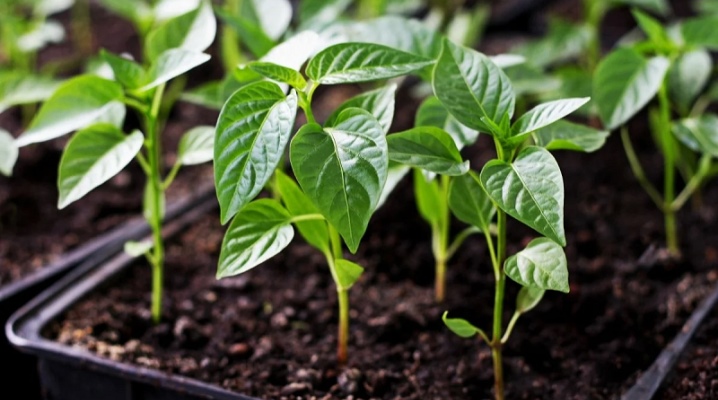
Sweet bell pepper is a culture that is tasty both fresh and heat-treated, and it knows very few competitors in the marinade. Therefore, if there is an opportunity to plant pepper on the site, then rarely anyone refuses to do so. But first, you will have to grow seedlings at home.
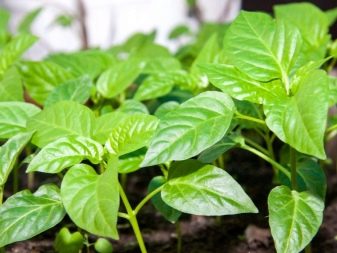

Sowing seeds
In late February or early March, you can already start seedlings. Truth, disembarkation time depends on the region, and the timing on the package is also worth looking at. The seeds themselves need to be bought in reputable stores, and if they are bought by hand, then they should not be random people. High-quality seed is a starter necessity. Next, you need to choose the soil: the right soil will become a home for seeds, which means that it is dangerous to miscalculate here too. Each particular crop requires a soil with its own characteristics. So, pepper needs loose earth, with good air permeability, moisture capacity, and neutral pH. And, of course, the substrate must be fertile. If it so happens that there is only soil with excess acidity, then dolomite flour or lime must be added to it (15 g per 1 kg of soil mixture).
If you don't want to buy land from the store, you can make a suitable substrate yourself. You need to take garden soil from the place where eggplants, potatoes, the same pepper have not grown for several years. The primer will need 2 parts. And to it are added 1 part of peat, 1 part of sawdust (can be replaced with river sand), 1 part of humus and a handful of wood ash. Then everything cooked should be filtered through a sieve. And 2-3 days before the direct sowing of seeds, the soil can be processed with "Previkur" or its analogue. You can sow seeds in plastic cassettes (these are such connected cells) or in ordinary plastic cups. Peat tablets will also be a convenient option, which completely eliminate the need to prepare the soil. They just need to be moistened, and the seedlings will grow well in them.
They have only one minus - the high cost (relative to the same plastic cups).
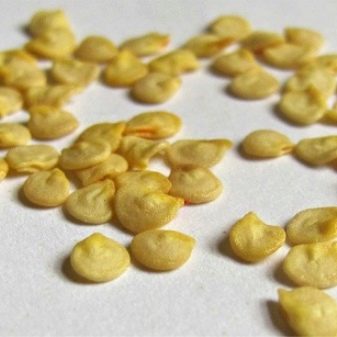

Let's take a look at how to prepare the seeds correctly:
- disinfect: immerse in not the weakest solution of potassium permanganate for 20 minutes, and then rinse with clean water;
- feed, for example, 1 teaspoon of "Nitrofoski" mixed with 1 liter of water;
- germinate in a nutrient solution ("Ideal" or "Gumi"), wrap with a damp cloth, send into polyethylene;
- harden: first send it to the refrigerator for a couple of days, then to a room for a day, where it will not be higher than +20, and then again to the refrigerator for 2 days.
And only after that, the seeds can finally be sown.
Sowing bell pepper seeds step by step looks like this.
- Put a layer of drainage about 1 cm thick on the bottom of the container.
- Fill the container with soil, pour abundantly with clean water (settled), room temperature.
- Make centimeter indentations in the ground. If sowing is done in a container or box, that is, in a common container, grooves are made in the ground, also in a centimeter. And the distance between them is 3 cm.
- Then you can start planting: one seed per hole, if it is a peat tablet or a glass. If sowing goes into a common container, an interval of 2 cm is observed between the seeds.
- The seed should be covered with soil.
- Then the soil mixture is moistened with water from a spray bottle. The container is covered with foil (glass is also possible) to form a mini-greenhouse. And all this goes to a warm place.
And you can open seedlings only when shoots (sprouts) appear.
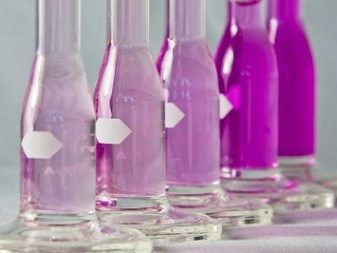
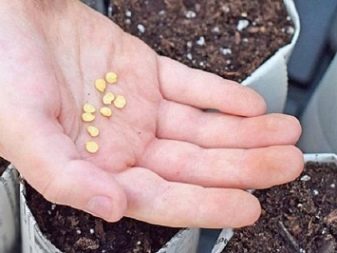
Home care
At home, conditions can be created for the pepper so that the seedlings will grow strong, healthy, with good survival rates on the site. And leaving is a complex of not the most difficult, but requiring a system of actions.
Lighting
Natural light is certainly lacking in spring or late winter. And for seedlings you need 12 hours of light every day, or even better - 14. And then phytolamps come to the rescue. Yes, you need to spend money, but after all, the purchase is not seasonal, they will last a long time. Most often, you have to highlight the peppers growing on the windowsill.
Temperature
It may be slightly higher than room temperature, preferably +25 degrees. The seedlings rot from the low temperature, and if it is high, they will overheat. The temperature regime is very important, therefore it is imperative to adhere to the optimal values.
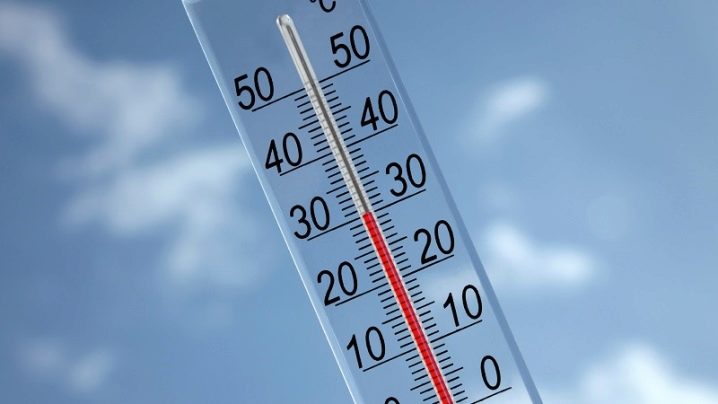
Watering
Moderate watering is also important for peppers. Just as after sowing, the soil is sprayed from a spray bottle, so for the first 3 days they continue to do the same. Moderate humidity should be maintained. Then you will have to water from a watering can or use a syringe, irrigating along the edge of the container. It is necessary to check the condition of the topsoil.
Only clean water with room temperature indicators is used for irrigation.
Loosening
If a so-called soil crust forms (and this happens very often), the soil must be loosened. So it will be easier for oxygen to penetrate the soil, get close to the root system. But at the same time, loosening should be superficial. It is impossible to do this very actively, because the roots can be injured.
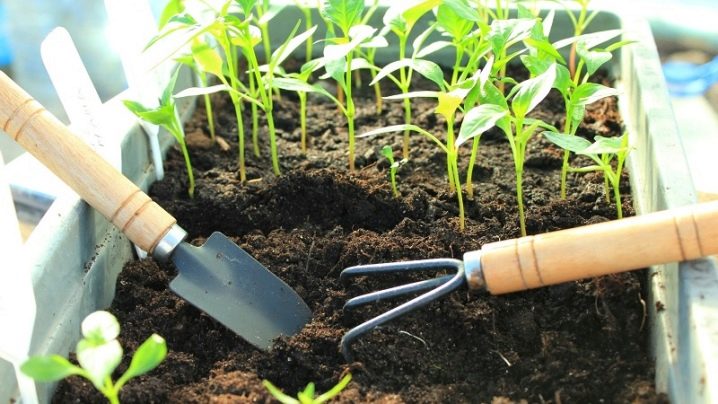
Top dressing
Usually, pepper is fertilized with complex compounds. The first time - 2 weeks after the pick, then again after 2 weeks and, finally, a week before landing in the ground. Regulators and growth stimulants are used: these are special fertilizers from the store, and something from the series "found on the farm" (for example, eggshells). Hydrogen peroxide, potassium humate, calcium nitrate, and succinic acid are also used. Not all at once, but something from the list. Also, the earth can be fed with ash.
Dive
If the seeds were planted in a box, picking is indispensable. And they usually do it by transshipment. This is necessary so as not to disturb the roots once again. Yes, there is an opinion that picking is an unnecessary operation, and without it the peppers will grow quite normally. But the plants will be disturbed, which means they will be vulnerable and capricious (this is the opinion of skeptics). But there really is no one, you need to rely on your intuition and experience. Peppers from a large container are transferred to individual ones when the first 2-3 leaves appear on the shoots. But if you delay with this moment, the threat of root entanglement will be high.
Seedlings transferred from a common box into small containers cannot be placed deeper than in the previous container. If deepened too deep, the stem can rot, because such a plant will not give additional lateral roots.

How to care for seedlings in the ground?
Bell peppers can be grown outdoors or in a greenhouse. Further care of the seedlings will depend on the place of cultivation.
In the open
The pepper should grow in a well-lit area that is protected from drafts. Tall crops will provide additional protection from the wind. You can put a wicker fence, if possible. A month before planting the pepper, the soil must be dug up, rotted manure must be added to it, which is mixed with wood ash. 2 weeks before planting pepper, the ground is disinfected with copper sulfate at the rate of 1 tablespoon per 10 liters of water.
It is time to transplant peppers into open ground if the difference between day and night temperatures is about 8 degrees. The seedlings tolerate such a jump normally, but if they have not grown stronger, there may be problems. And with return frosts, you need to be careful. Therefore, it is better to cover the beds: either with a film greenhouse, or something similar.The shelter works at night and lasts at least a week after landing. In principle, the shelter may not be removed until mid-June.
Care features:
- seedlings should be watered a week after transplanting, and at first watering will be daily, with a rate of 150 ml per plant;
- you can water only at the root;
- after each watering, after 5 hours, the soil is loosened so that there is no crust;
- you need to feed the peppers during the flowering period, when the fruits are set and ripen, fertilizers should be applied every 2 weeks all summer;
- from organic matter, infusion of wood ash, infusion of bird droppings, diluted 1 to 10 humus, diluted 1 to 15 liquid manure are used;
- if the peppers are grown with irregular watering, they must be mulched;
- hay, pine needles, chopped bark, sawdust will do as mulch;
- the formation of a bush will occur as it grows: you can pinch only at a height of 20 cm, so that lateral shoots grow;
- after formation, 15-20 ovaries should remain on each bush;
- to stimulate ripening at the end of the season in the last weeks of summer, you need to cut off the entire top of the bush;
- if the variety is tall, the plant must be tied up.
Planting outdoors is always a risk, especially if it's not in the southern region. In the middle lane, for example, much more often peppers are grown in a greenhouse.
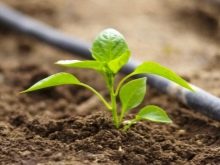
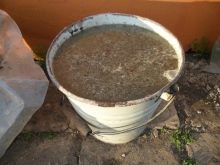

In the greenhouse
Do not plant peppers in the same greenhouse where nightshades grew last year. But if there is no other place, then you need to prepare the beds in the greenhouse in the fall. The earth is fertilized and disinfected. Probably the best place for peppers is a polycarbonate greenhouse. There will not be significant temperature changes, and the plant will be as comfortable as possible.
Features of transplanting into a greenhouse and subsequent care:
- deepening can be done only to the height of the container where the seedlings grew;
- a handful of peat can be added to each hole;
- 30 cm or a little less should remain between the bushes, and 80 cm between the beds;
- the ground around the bushes must be covered with a layer of humus;
- the first watering is carried out no earlier than 10 days later;
- the greenhouse is ventilated daily, the air humidity is controlled.
The rest of the care of pepper in the greenhouse is comparable to the same procedures in the open field.
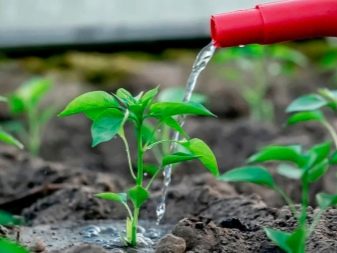
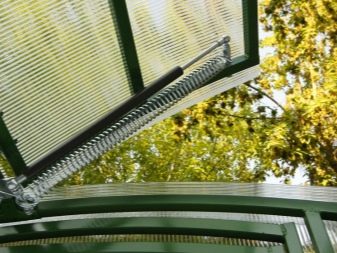
Diseases and pests
Aphids, May beetle and Colorado Potato beetle are the main pests for bell peppers. And insectoacaricides, the same Fitoverm, cope well with them. Aphids are considered especially dangerous, which very quickly grows their colony. It is better to be ready in advance to meet her: put balls rolled from powdered sugar, boiled yolk and boric acid in the greenhouse (this rarely happens with seedlings at home).
Now let's look at the most common diseases of pepper.
- If dark spots appear on the leaves, the root collar has rotted, and the fruits are full of watery areas, it is probably late blight. Need treatment with "Barrier", "Alirin" or "Barrier". The bushes affected by the disease will have to be dug up and burned.
- Brown and brown spots on the leaves are anthracnose. Young plants will wither from the top, then they turn yellow and die. Need prompt processing "Antracol" (according to the instructions for use).
- Root rot (black leg) is a disease with a disturbed irrigation system, when the plant and the ground are waterlogged. Will help "Fitosporin" and watering the soil with potassium permanganate.
- If the upper tier of the foliage withers, it must be Fusarium. The plant may also turn yellow, and necrotic spots and pinkish spores will appear in some of its areas. Affected plants will have to be dug up. Will help the bushes "Fundazol", "Maxim" and their analogues.
- Weeping dark spots and olive spots on the fruit that appear on the leaves are likely to be symptoms of gray mold. Treatment is possible only at the beginning of the disease, and here "Gamair" and "Topsin" will help.
These are not all pepper diseases, but they are quite common. Any drug, be it "Epin" or "Aktara", should only be diluted according to the instructions, do not do anything by eye.And in order to prevent diseases, you should use only sterile garden tools, observe the basics of agricultural technology, crop rotation, regularly weed the beds, etc.
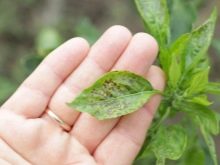
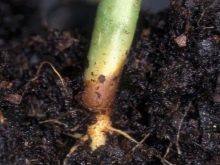
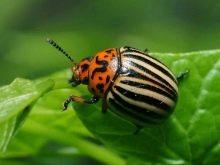
Growing problems
There can be many errors, and it is better to know about them in advance:
- if the seedlings are stretched out and become thin, it means that they do not have enough light, you need to additionally highlight the seedlings;
- if the seed material has not sprouted or it takes a long time to sprout, you need to adjust the temperature regime (before the emergence of shoots +25 there is a norm, after the appearance - +20);
- if the bush grows poorly in height, it is possible that the soil was chosen incorrectly, and the temperature is low, and there is little watering, and they hurried with a dive;
- if the plant withers and falls, then one of the reasons lies in the violation of the water regime: perhaps the peppers forget to water.
There is no need to be afraid to use growth stimulants, because without them, the seedlings may not reach the desired development so that they can be transplanted into the ground. When growing seedlings of peppers, many actions, if not intuitive, then simply require logical thinking.
Starting from the fact that it is not worth pouring non-disinfected garden soil into a good store soil mixture and ending with the choice of zoned varieties.
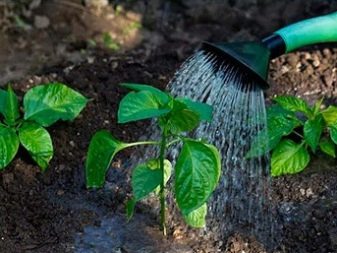
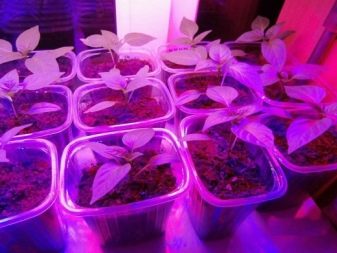









The comment was sent successfully.